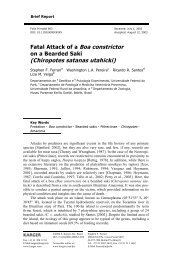Dissertação apresentada ao Colegiado do Programa de Pós ...
Dissertação apresentada ao Colegiado do Programa de Pós ...
Dissertação apresentada ao Colegiado do Programa de Pós ...
You also want an ePaper? Increase the reach of your titles
YUMPU automatically turns print PDFs into web optimized ePapers that Google loves.
Ana Paula Car<strong>do</strong>so Pra<strong>do</strong> Pereira. Feeding Ecology of Cuxiú-Preto (Chiropotes satanas<br />
satanas) at Fazenda Amanda, Pará. Belém, Pará, 2002. 65 pages. Master’s Degree<br />
Dissertation. Universida<strong>de</strong> Fe<strong>de</strong>ral <strong>do</strong> Pará. <strong>Programa</strong> <strong>de</strong> <strong>Pós</strong>- Graduação em Teoria e<br />
Pesquisa <strong>do</strong> Comportamento.<br />
ABSTRACT<br />
Bear<strong>de</strong>d sakis (Chiropotes spp.) are medium-sized Neotropical primates of the family<br />
Pitheciidae, frugivores specialised for seed predation. The southern bear<strong>de</strong>d saki,<br />
Chiropotes satanas satanas, is the only pitheciid found in eastern Amazonia, and is<br />
consi<strong>de</strong>red to be one of the most endangered primates in Brazilian Amazonia. The main<br />
objective of this study was to characterise the feeding ecology of C.s. satanas in a<br />
fragment of primary forest on Fazenda Amanda, in the municipality of Viseu, in the<br />
northeast of the Brazilian state of Pará, in or<strong>de</strong>r to obtain data relevant to the saki’s<br />
conservation. The study was carried out between January and July 2000. Four types of<br />
research were conducted: a survey of mammal populations; monitoring of the availability<br />
of plant food resources (phenology); collection of quantitative behavioural data on the<br />
sakis and interviews with local resi<strong>de</strong>nts. The 180 km line transect survey recor<strong>de</strong>d the<br />
presence of six species of primate, and a further 22 species of mammal. The results<br />
indicate that sakis were relatively abundant at the study site in comparison with other<br />
localities in the region, although the <strong>de</strong>termining factors remain unclear. The results of the<br />
phenological study reveal some seasonal variation in the availability of reproductive parts<br />
of different plant species, but little functional variation in the availability of resources for<br />
the sakis. The study subjects exhibited typical saki behaviour patterns, with a fluid social<br />
organisation (fission-fusion) and a diet rich in fruits and seeds (both ripe and unripe). As at<br />
other sites, species of the families Lecythidaceae and Sapotaceae pre<strong>do</strong>minated in the diet,<br />
although new taxa, including a family (Ebenaceae) were recor<strong>de</strong>d. The information<br />
supplied by interviewees indicate that, while hunting is a common activity in the area, the<br />
sakis are currently un<strong>de</strong>r no hunting pressure, which may explain, at least partially, their<br />
relative abundance at the site. Despite the present situation at Fazenda Amanda, the recent<br />
history of habitat fragmentation and the growing pressure from the local human population<br />
suggest that the management of its populations of sakis and other mammals will <strong>de</strong>pend on<br />
the implementation of a series of practical measures, in particular the stimulation of<br />
environmental consciousness in local resi<strong>de</strong>nts and lan<strong>do</strong>wners.<br />
Key words: Feeding ecology, conservation, management.<br />
VII



